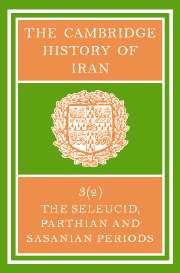Book contents
- Frontmatter
- PART 5 INSTITUTIONS
- 18 IRANIAN SOCIETY AND LAW
- 19 POLITICAL, SOCIAL AND ADMINISTRATIVE INSTITUTIONS, TAXES AND TRADE
- 20 GEOGRAPHICAL AND ADMINISTRATIVE DIVISIONS: SETTLEMENTS AND ECONOMY
- 21(a) TIME-RECKONING
- (b) IRANIAN FESTIVALS
- PART 6 RELIGIOUS HISTORY
- PART 7 ART HISTORY
- PART 8 LANGUAGES AND LITERATURE
- PART 9 BIBLIOGRAPHY
- Bibliography
- Index
- Index of Greek words
- References
21(a) - TIME-RECKONING
from PART 5 - INSTITUTIONS
Published online by Cambridge University Press: 28 March 2008
- Frontmatter
- PART 5 INSTITUTIONS
- 18 IRANIAN SOCIETY AND LAW
- 19 POLITICAL, SOCIAL AND ADMINISTRATIVE INSTITUTIONS, TAXES AND TRADE
- 20 GEOGRAPHICAL AND ADMINISTRATIVE DIVISIONS: SETTLEMENTS AND ECONOMY
- 21(a) TIME-RECKONING
- (b) IRANIAN FESTIVALS
- PART 6 RELIGIOUS HISTORY
- PART 7 ART HISTORY
- PART 8 LANGUAGES AND LITERATURE
- PART 9 BIBLIOGRAPHY
- Bibliography
- Index
- Index of Greek words
- References
Summary
ELEMENTS OF TIME-RECKONING
Every method of time-reckoning uses and combines three natural time elements: day, lunation, and year. Since the day is the indispensable component of time measurement, three combinations of natural time units are possible: (a) days plus lunations; (b) days, lunations, and year; and (c) days and year. The extant evidence shows that the Persian, Macedonian and Parthian rulers of Iran, from the 6th century b.c. until the 3rd century a.d., used the second scheme (b). The Sasanians in the 3rd to 7th centuries a.d. used the third scheme (c), as do the Zoroastrians to this day. Before explaining the intricacies and history of these calendar types in pre-Islamic Iran, some comments on the chronological terms used in this chapter may be of use.
For the purposes of time-reckoning, the “day” includes the night-period between two successive daylights. The peoples who used the moon as a marker of time, for instance the Babylonians, counted the complete night and day as a single “day”, (from onset of evening to onset of evening), whereas the Zoroastrians, who disregarded the lunar reckoning entirely, insisted that the calendar day was the period between two sunrises.
The waxing and the waning of the moon recur about every 29 days, and the calendar month began at the appearance of the new moon. As its visibility depends on many accidental and variable factors, e.g. the cloudiness of the sky, the month for the purpose of the calendar was counted as having twenty-nine or thirty days.
- Type
- Chapter
- Information
- The Cambridge History of IranSeleucid Parthian, pp. 778 - 791Publisher: Cambridge University PressPrint publication year: 1983
References
- 2
- Cited by



